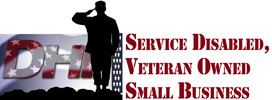Metal Fiber Brushes (MFBs) for De-icing Applications

Defense Holdings, Inc.® (DHi) and HiPerCon, LLC® of Charlottesville, VA have teamed to extend the use of their revolutionary, patented Metal Fiber Brush (MFB) technology from use in U.S. Navy nuclear submarines to propeller deicing systems for fixed- and rotary-wing aircraft. In every field application, the MFBs have exhibited at least twice the service life of carbon brushes in side-by-side testing and have eliminated the most traditionally troublesome aspects of systems with carbon brushes.
Following in the wake of their successes with submarine applications, DHi and HiPerCon adapted their submarine MFBs to solve de-icing system problems for the Navy’s E-2C early warning aircraft and the U.S. Air Force’s C-130 aircraft. The Air Force needed an improved alternative to the use of carbon brushes in propeller de-icing systems in the C-130 aircraft fleet.
The USAF expects that transitioning its C-130 propeller de-icing systems from carbon brushes to metal fiber brushes will result in significant cost savings in spare parts as well as fewer maintenance inspections and increased operational availability of the platform.
Aircraft propeller de-icing systems (and many helicopter rotor de-icing system as well) use carbon “brushes” sliding across a rotating slip ring to transfer electrical power from the engine to the rotating propeller (or rotor) blades. This electricity is applied to heater elements in the blades to shed ice accumulation. These carbon brushes exhibit significant wear resulting in large amounts of carbon dust that greatly increases the potential for short circuits and fires on the engine mount during flight. With the traditional carbon brushes, maintenance personnel must take the aircraft offline, open the engine nacelles, remove the brush blocks, inspect and clean the brushes every 15 days to preclude fire danger. This cleaning and inspection process is a very dirty and time consuming job and negatively impacts the operational availability of the aircraft.
Cleaning a slip ring system with metal fiber brushes is also easier due to the nature of the debris, together with other benefits including overall system reliability. Transitioning from carbon brushes to metal fiber brushes will result in 2-to-1 cost savings in spare parts alone. Further cost savings are realized when accounting for the labor savings associated with fewer inspections and for the increased operational availability of the platform. The technology can be transitioned to virtually any propeller de-icing system, any slip ring system operating in severe environments, or any system requiring significant performance attributes where carbon brushes are not satisfying the requirement.
Marcel Piet, DHi’s Vice President for Product Research and Development, states “Defense Holdings is very pleased to have been named an Air Force ‘SBIR Success Story,’ particularly after have been named a U.S. Navy ‘SBIR Success Story’ back in 2005 where we were known as Noesis, Inc. The thing that pleases us most is being able to solve really challenging problems for our Warfighters.”
DHi and HiPerCon have already proven that our patented MFBs can operate under high runout conditions in excess of 50mils while under electrical loading and in the presence of industrial contaminates. Success of DHi’s program has proven that its MFBs can deliver a reliability improvement across a range of operating conditions ranging from controlled environments to harsh environments where carbon brushes increasingly fail. DHi and HiPerCon have developed the technology, have pioneered the MFB market, and are presently the largest supplier of these types of Metal Fiber Brushes in the world.



